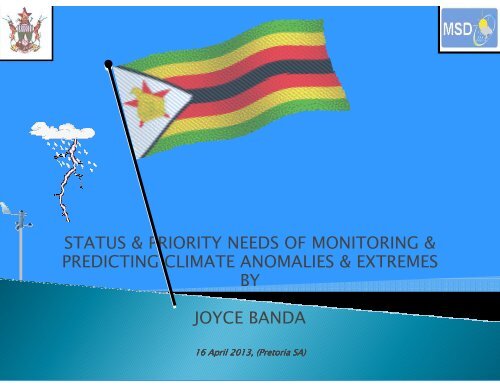Zimbabwe - WMO
Zimbabwe - WMO
Zimbabwe - WMO
You also want an ePaper? Increase the reach of your titles
YUMPU automatically turns print PDFs into web optimized ePapers that Google loves.
STATUS & PRIORITY NEEDS OF MONITORING &<br />
PREDICTING CLIMATE ANOMALIES & EXTREMES<br />
BY<br />
JOYCE BANDA<br />
16 16 16 16 April April April April 2013, 2013, 2013, 2013, (Pretoria (Pretoria (Pretoria (Pretoria SA) SA)<br />
SA) SA)
Outline:<br />
• Introduction<br />
• Climate Data and Observation.<br />
• Climate Monitoring.<br />
• Specific Issues Related to Climate Monitoring and<br />
Prediction in the Region.<br />
• User Activities In support Of Climate Risk Management<br />
& Early Warning Systems
Why Data Collection For <strong>Zimbabwe</strong><br />
One of the Meteorological Services Department’s (MSD) prime functions is the<br />
measurement and collection of accurate weather records whose main<br />
purpose is to contribute to the safety, security and general welfare of the<br />
<strong>Zimbabwe</strong>an community through performance of Meteorological functions.<br />
It is also responsible for the collection and long-term custody of reliable<br />
meteorological and climate data in fulfillment of the country’s and<br />
international obligations.<br />
> 70% of <strong>Zimbabwe</strong>’s population’s livelihood depends on agriculture and more<br />
than 10 million people directly benefit from agriculture and sub sectors<br />
related to it, Yet weather and climate are still the key factors in agricultural<br />
productivity in <strong>Zimbabwe</strong>.<br />
Need to increase the accuracy of the provision of weather forecasts, warnings,<br />
information and advisories for the general public and most major sectors of<br />
the society, including agriculture, aviation, tourism, environmental<br />
management and natural disaster mitigation
Current Data collection Position<br />
• 47 Manual Synoptic Stations manned by Met<br />
Personnel<br />
• 17 Part-time Manual Synoptic Stations<br />
manned by Agriculture Extension Officers.<br />
• ~300 Rainfall Stations (voluntary)<br />
MSD Strategic Plan On Data collection<br />
• To have installed 150 AWS by 2015<br />
-currently at 17.<br />
• To decentralize data capturing.<br />
• To enter into sustainable partnerships.
-16.00<br />
-17.00<br />
-18.00<br />
-19.00<br />
-20.00<br />
-21.00<br />
-22.00<br />
Victoria-Falls<br />
Hwange<br />
Binga<br />
Lupane<br />
Gokwe<br />
Nkayi<br />
Tsholotsho<br />
Nyamandhlovu<br />
Bulawayo<br />
Bulawayo-Goetz<br />
Matopos<br />
Plumtree<br />
Karoi<br />
Chinhoyi Banket<br />
Mutoko<br />
Trelawney Henderson<br />
Harare-Bvdre<br />
Harare-Kutsaga<br />
Harare-Apt<br />
Marondera<br />
KadomaMhondoro<br />
Nyanga-Exp<br />
Wedza<br />
Rusape<br />
Mukandi<br />
Kwekwe<br />
Chivhu<br />
Gweru<br />
Kezi<br />
West-Nicholson<br />
Thuli-Estate<br />
Beitbridge<br />
Makoholi<br />
Zvishavane<br />
Masvingo<br />
Guruve<br />
Mt-Darwin<br />
Mvurwi<br />
Buhera<br />
Zaka<br />
Middle-Sabi Chipinge<br />
Chisumbanje<br />
Buffalo<br />
Chisengu<br />
26.00 27.00 28.00 29.00 30.00 31.00 32.00 33.00
Sparse observation network that provides input to NWP models is a<br />
cause for concern as it affects quality of forecasts.<br />
Not an exact science-probabilistic<br />
Exact timing of events not known<br />
Understandability and interpretation of the forecast<br />
If farmers do not understand the forecast (probabilistic terms),<br />
they may ignore it or use it wrongly thereby making wrong<br />
decisions. AN=floods?, BN= Drought?<br />
Timely communication<br />
-Forecast not useful if it comes when farmers have already planted<br />
or purchased certain seed varieties.<br />
Translation<br />
-Some technical terms are difficult to put into local language
Credibility:<br />
If previous forecasts were viewed as “wrong” , people will not believe<br />
subsequent forecasts.<br />
Communication Channels Used:<br />
Certain media( print or electronic) not appropriate for certain communities ,<br />
will not be able to reach many people.<br />
Scale:<br />
Farmers require a more localized seasonal climate forecast but current<br />
advances in seasonal climate forecasts only provides generalized regional<br />
climate information relevant to seasonal time scales and relatively large<br />
areas.<br />
Access to inputs( cost and/or availability)<br />
Seed ,fertilizer, draught power etc<br />
Farmers fail to take advantage of a favorable forecast.<br />
Feedback<br />
Was information provided useful and/or accurate?<br />
Enables tailoring of product to suit needs of different users.
Early Early warning warning systems<br />
systems<br />
The existence of an early warning<br />
mechanism involving the Meteorological<br />
Services Department and the Civil<br />
Protection organisation in <strong>Zimbabwe</strong>,<br />
Ministry of Local Government, Rural and<br />
Urban Development (Department of Civil<br />
Protection) plays the coordinative role in<br />
DRR activities.<br />
Regional<br />
Regional<br />
◦ SADC-CSC
-Many Disaster Risk Reduction and<br />
adaptation projects are currently being<br />
driven by the Governments and local and<br />
international NGOs, NGO’s and self-help<br />
groups have started initiatives to reduce<br />
vulnerability to drought.<br />
-Rehabilitation, better land-use planning<br />
and building regulation at the community<br />
level<br />
-Integration of DRR into the education<br />
system of the country
National Civil Protection<br />
Plan<br />
Provincial Civil Protection<br />
Plans<br />
Sectoral /<br />
District Civil Protection<br />
Plans<br />
institutional Plans Community plans
-Local (affected) communities have a much<br />
bigger role to play. As a result, they are<br />
involved in planning.<br />
-They are the custodians of local coping<br />
strategies (Indigenous Knowledge Systems)<br />
that can be used as initial early warning and<br />
response mechanisms.<br />
-Vulnerable communities are being<br />
capacitated in DRR activities
EXAMPLE OF WARNING THAT CAN BE ISSUED:<br />
IMMEDIATELY GET OFF ELEVATED AREAS SUCH AS HILLS,<br />
MOUNTAIN RIDGES OR PEAKS<br />
NEVER LIE FLAT ON THE GROUND<br />
NEVER USE A TREE FOR SHELTER<br />
NEVER USE A CLIFF OR ROCKY OVERHANG FOR SHELTER<br />
IMMEDIATELY GET OUT AND AWAY FROM PONDS, LAKES AND<br />
OTHER BODIES OF WATER<br />
STAY AWAY FROM OBJECTS THAT CONDUCTS ELECTRICITY<br />
(BARBED WIRE FENCES, POWER LINES, WINDMILLS,<br />
ETC.)
















